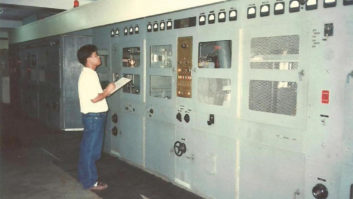
The series is based on the premise that the time to do heavy thinking about what a reporter will have to bring to the field and how the reporter will work in the field is before the reporter actually has to go to the field. What a novel concept for a business that thrives on spontaneity.
With that said, let’s look at how reporters organize and transport their gear to and from assignments.
Be prepared
If like me you have been in the business for a few years and you’ve made more than your share of mistakes or missed the “money quote” because you didn’t have a backup item, you tend to bring everything you could possibly need in the field to an assignment — but likely won’t.
Common sense dictates that you bring what you need to complete the assignment. Some reporters, like WSB(AM)’s Peter Combs — whom you also will hear on CBS News Radio, covering hurricanes and such — tend to take the ultra-portable backpack route. Others use a variant of the soft-sided briefcase/business case on wheels. I’ve schlepped too many backpacks in my day, so I use a Zero aluminum case to transport my laptop and basic gear from car to venue.
What you take with you depends on what makes you comfortable and confident. Both comfort and confidence will help you do a better job when you roll up to a venue knowing you’re ready for what may happen next.
I talked with Peter just after he stood down from hurricane season; he shared some insights with me.
Peter uses a Dell Computer backpack, which by his calculation weighs 40 to 45 pounds when full of gear.
“I’ve had it for about two years, and I can find anything in that pack without looking,” he said. That particular bag has a lot of side pouches, which Peter fills with batteries (“You can never have enough”), pigtail connectors, mic and USB cords, etc. He usually carries it by one strap over the shoulder if the walk is short; longer walks have him use both straps over both shoulders.
When he has to go into hurricane areas, Peter wraps each item in plastic before placing it in the backpack. He wears the top half of a rain suit with almost as many pockets as the Dell backpack, so the gear he carries stays dry.
His advice for fellow road warriors: “Remember that you’re basically a self-contained broadcast unit out there. Wherever you are, it’s a good bet that if you don’t have it, you will have to do without it.”
(click thumbnail)The Bugout BagYou can choose backpacks that range from the drugstore/discount store type to the same style of duty packs carried by soldiers and Marines. A value-priced alternative is the “Bugout” gear made by Piper Gear in Chula Vista, Calif. You’ve likely seen some of their products if you’ve seen soldiers and Marines moving through airports.
The Bugout bag is a popular item in the military exchanges and is used to haul personal gear back and forth. It can be carried like a soft-sided case, and when necessary, the back straps come out so the case can be carried on the back.
Reggie Regala from Piper Gear’s marketing division says his company’s products may not be the most expensive, “but they are functional and affordable with high-end features. We get input from the people who are using them (in the field), and we listen to that very carefully.”
The Bugout bags are made from a polyester canvas, which has some inherent water resistance.
“Because of the zipper,” says Regala, “we can’t call them waterproof bags. We do design them with a hood over the zipper to keep water away. They will clean up with a damp rag, and for stubborn soil, a little dishwashing soap.”
Then there’s the Pelican thermoplastic case, somewhat light and very strong. You’ll see these with military units moving sensitive and fragile equipment from place to place.
At Soldiers Radio and TV in Washington, we sent soldiers to Saudi Arabia and Kuwait during the Gulf War with a radio news kit (recorder, adapters, single-line Comrex, etc.) that was fitted into a Pelican case — my first experience with these light and strong cases, whose modern-day models reportedly have survived a hit with an improvised explosive device in Iraq.
(click thumbnail)Pelican Case Under TruckChief Engineer Gene Gunderson says those cases allow him “to pack a large quantity of equipment and supplies for support.” Care and maintenance are fairly straightforward: “a wipe down with a damp rag, and some TLC and a little preservative for the plastic.”
Gunderson has a note for those who travel by air and want to take what they need but keep the weight down: “If they must consider weight, equipment and flexibility, it (the Pelican case) is a product to look at.” Pelican cases come with wheels as an option.
Travelin’ tight
I’ll share a personal experience about cases.
I had been given a Zero aluminum tool case a few years ago. I figured out how to pack a laptop and its peripherals, along with a flash-card recorder, two microphones, cords, adapters and a JK Audio RemoteMix Sport and its peripherals into the case.
One day at the Secaucus Junction train station in New Jersey, my Zero case, loaded with equipment, came loose from the strap which fastened it to a suitcase. The case slid and fell from the top of the stairs on the train platform to the bottom of the stairs.
If I had my gear in a soft-sided suitcase, I would likely have spent a few thousand dollars to repair or replace a laptop and recorders, which likely would have been in figurative and literal pieces after that 20 foot fall. The sole result was a dent in the corners of the Zero case, and some scratches.
Carrying the case, about 30–35 pounds loaded, helps me to get some exercise, so there’s a side benefit as well.
(click thumbnail)Zero Case With DentsZero cases are drawn from a single sheet of aluminum over a die. The process uses 440 tons of pressure to rearrange the hi-tensile aluminum, without adding wrinkles or distortion in the finished surface. The cases provide 360 degree protection, as the entire case is made from aluminum. Other cases may just be reinforced at the corners.
Aluminum provides corrosion resistance, high strength to weight ratio and shielding against more than moisture, dust and extreme temperatures — Zero cases can provide some protection against RFI/EMI interference. Maintain them with some industrial cleanser and a rag to get rid of the scuffs. Zero cases also come with optional wheels.
How do you keep a big case organized? You use little packs and bags to organize the loose stuff so everything fits comfortably. What style of small packs you use is up to you. It helps when, not if, you are selected by the Transportation Security Administration for follow-up screening at airports.
Small packs can provide a degree of padding too. You also can use the foam inserts that come in hard-sided cases, if you only carry a few but relatively fragile items.
The next edition of Road Warrior Radio will deal with getting audio in and out of a PCS digital flip or brick handheld cell phone; the analog bag phones are going away. We’ll look at the problem and bring you real-world solutions that can mean the difference between getting on the air, and not.
Don’t hesitate to contact me at [email protected] if you have a problem you’d like for us and our readers to solve, or an idea for a future column; those ideas and comments help us focus on the tips, tricks and trends that are important to you, our readers.















